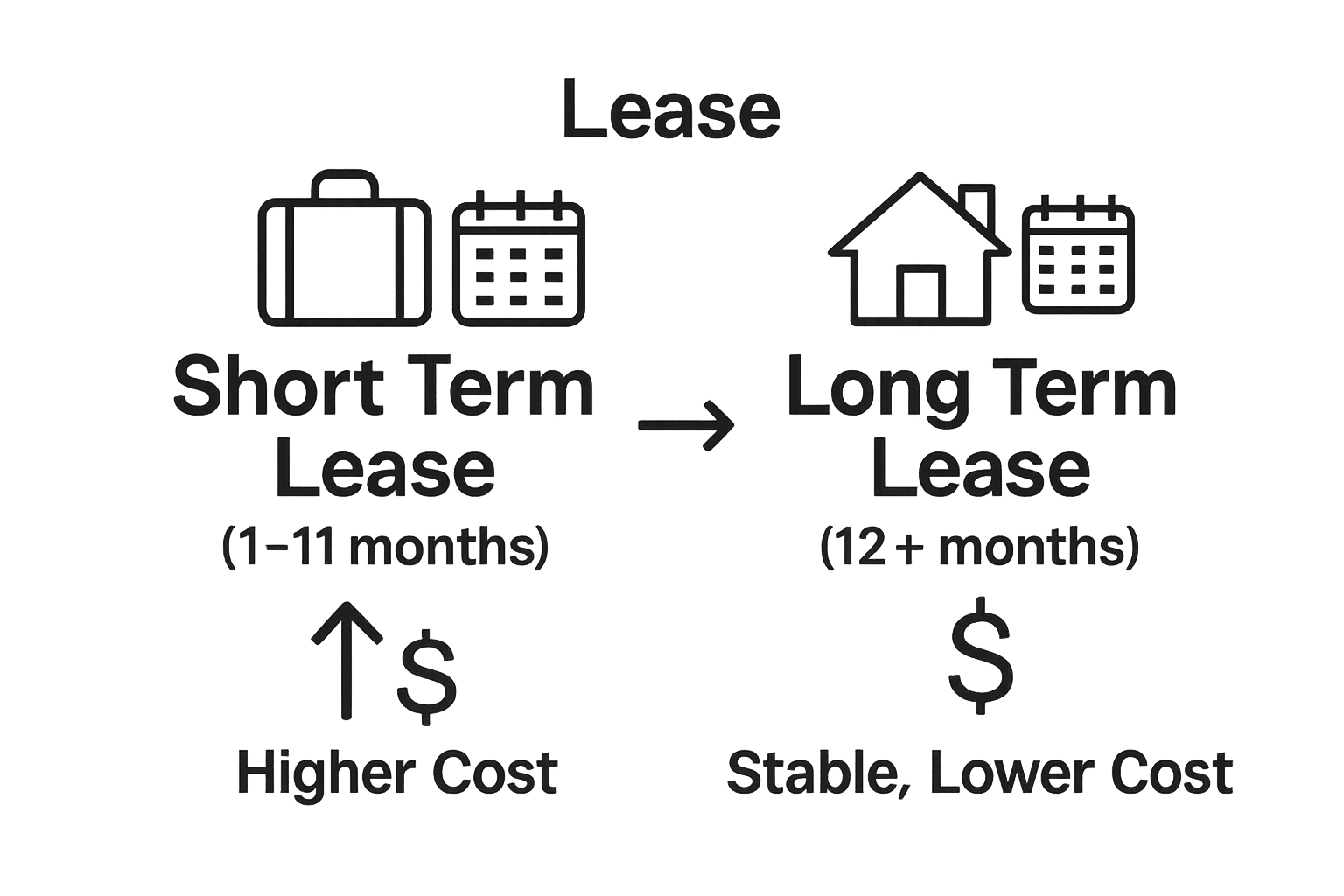Long-term leases have quietly shaped the way people rent homes and invest in property. Most people think short-term rentals are more popular, but the numbers tell a different story. A typical long-term lease lasts for 12 months or more, offering tenants stability and landlords a predictable income stream. The biggest surprise isn’t just about security. The real advantage lies in how these agreements can reduce turnover, lower costs, and help both sides plan their next move with confidence.
Defining a Long Term Lease and Its Duration
A long-term lease represents a specialized rental agreement that extends significantly beyond traditional short-term housing arrangements. Unlike standard monthly rentals, these leases provide tenants with extended occupancy rights and landlords with more predictable income streams.
What Constitutes a Long Term Lease
Generally, a long-term lease is defined as a rental agreement lasting 12 months or longer. This duration distinguishes it from short-term leases, which typically cover periods less than one year. The extended timeframe offers multiple advantages for both property owners and tenants, creating a more stable housing relationship.
Key characteristics of long-term leases include:
- Predetermined rental rates for the entire lease duration
- More comprehensive legal protections for both parties
- Reduced administrative overhead compared to frequent lease renewals
Legal and Practical Implications
Long-term leases carry specific legal frameworks that differ from shorter rental agreements. They often require more detailed documentation and provide greater security for tenants. Property owners benefit from reduced vacancy risks and more consistent revenue projections.
For tenants, a long-term lease offers:
- Residential stability
- Predictable housing costs
- Protection against sudden rental increases
- Potential negotiation leverage for property improvements
Typical long-term lease durations range from 12 to 36 months, though some specialized agreements can extend even longer. The specific terms depend on local regulations, property type, and mutual agreement between the tenant and property owner.
Understanding the nuances of long-term leases helps both tenants and property owners make informed decisions about their housing and investment strategies. Careful consideration of individual needs, financial circumstances, and long-term goals is essential when entering such an agreement.
Key Differences Between Long Term and Short Term Leases
Navigating the rental landscape requires understanding the fundamental distinctions between long-term and short-term lease arrangements. While both serve housing needs, they offer dramatically different experiences, financial implications, and legal protections for tenants and property owners.
Flexibility and Commitment
Short-term leases provide maximum flexibility, typically ranging from one to eleven months. These arrangements allow tenants to quickly change locations with minimal long-term commitment. Long-term leases, conversely, demand a more substantial commitment, usually spanning 12 to 36 months.
Key flexibility differences include:
- Short-term leases enable easier relocation
- Long-term leases offer stability and predictability
- Termination costs vary significantly between lease types
Financial Considerations
Financial structures differ markedly between these lease types. Short-term leases often command higher monthly rental rates to compensate for increased property management complexity and potential vacancy risks. Long-term leases typically offer more favorable rates, reflecting the tenant’s extended commitment and reduced operational expenses for property owners.
Financial implications to consider:
- Short-term leases generally have higher per-month costs
- Long-term leases provide more predictable financial planning
- Negotiation potential increases with longer lease durations
Legal and Operational Protections
Legal frameworks surrounding lease types create significant differences in tenant and property owner rights. Short-term leases typically require more frequent contract renewals and offer less comprehensive legal protections. Long-term leases establish more robust agreements, with clearer terms regarding rent increases, maintenance responsibilities, and potential dispute resolutions.
Long-term leases inherently create a more stable housing ecosystem, reducing administrative burdens and providing greater security for all parties involved. Tenants gain residential stability, while property owners secure consistent revenue streams and minimize turnover-related expenses.
Understanding these nuanced differences empowers both tenants and property owners to make informed decisions aligned with their specific housing and investment objectives.
To clarify the distinctions between long-term and short-term leases, the following table compares their key characteristics, financial implications, and legal protections.
| Aspect | Long-Term Lease | Short-Term Lease |
|---|---|---|
| Typical Duration | 12 to 36 months | 1 to 11 months |
| Flexibility | Lower; requires greater tenant commitment | Higher; easier relocation for tenants |
| Monthly Rent | Usually lower due to extended periods | Typically higher to offset turnover risk |
| Income Predictability | High for property owners | Lower, with possible income interruptions |
| Legal Protections | More comprehensive and clearly defined | Less robust, frequent renewals required |
| Administrative Burden | Reduced due to fewer tenant changes | Higher with frequent contract renewals |
| Risk of Vacancy | Lower for owners | Higher due to shorter occupancy periods |

Why Long Term Leases Matter for Property Owners
Property ownership represents a significant investment, and long-term leases emerge as a strategic mechanism for maximizing returns and minimizing operational complexities. These extended rental agreements transform traditional property management approaches, offering substantial advantages beyond standard short-term arrangements.
Financial Stability and Predictable Income
Long-term leases create a reliable financial foundation for property owners. By securing tenants for extended periods, typically 12 to 36 months, owners eliminate the constant uncertainty associated with frequent tenant turnover. This stability translates directly into predictable monthly income streams, enabling more accurate financial planning and investment strategies.
Key financial benefits include:
- Consistent monthly rental revenue
- Reduced marketing and screening expenses
- Minimized income interruptions between tenant transitions
Operational Efficiency and Cost Reduction
Beyond financial predictability, long-term leases dramatically streamline property management processes. The reduced frequency of tenant changeovers means fewer administrative tasks, lower maintenance interventions, and significantly decreased operational costs. Property owners can allocate resources more strategically, focusing on property enhancement rather than constant tenant recruitment.
Operational advantages encompass:
- Lower tenant acquisition costs
- Reduced property preparation expenses
- Simplified maintenance scheduling
- Decreased wear and tear from frequent move-ins and move-outs
Property Value and Investment Protection
Long-term leases serve as a protective mechanism for property investments. Stable, responsible tenants who commit to extended stays are more likely to treat the property with care, preserving its condition and long-term market value. Moreover, consistent occupancy rates enhance the property’s attractiveness to potential future buyers or investors.
The strategic approach of cultivating long-term tenant relationships transforms property ownership from a transactional model to a relationship-driven investment strategy. By prioritizing tenant satisfaction and offering competitive, fair lease terms, property owners can create a sustainable and profitable rental ecosystem.
Ultimately, long-term leases represent more than just rental agreements. They are sophisticated tools for financial management, risk mitigation, and portfolio optimization in the competitive real estate landscape.
Essential Components of a Long Term Lease Agreement
A comprehensive long-term lease agreement functions as a critical legal document that establishes clear expectations and protections for both tenants and property owners. Understanding its essential components ensures a transparent, legally sound rental relationship that minimizes potential conflicts and misunderstandings.
Fundamental Identification and Terms
The foundation of any long-term lease begins with precise identification details. This section must explicitly outline the property address, full names of all tenants and property owners, lease start and end dates, and specific rental terms. Clear identification prevents ambiguity and establishes legal accountability for all parties involved.
Key identification components include:
- Complete legal names of tenants and property owners
- Exact property address and unit details
- Precise lease duration with start and end dates
- Specific rental payment amount and due dates
Financial and Occupancy Provisions
Financial terms represent the most critical section of a long-term lease agreement. Beyond basic rental rates, these provisions detail payment expectations, security deposit requirements, potential late payment penalties, and rent adjustment mechanisms. Transparent financial clauses protect both tenant and property owner by establishing clear economic boundaries and expectations.
Critical financial provisions encompass:
- Monthly rental rate and payment schedule
- Security deposit amount and return conditions
- Utilities responsibility allocation
- Potential rent escalation clauses
- Late payment penalties and grace periods
Maintenance, Usage, and Termination Conditions
Detailed maintenance responsibilities and property usage guidelines form the operational core of a long-term lease. These sections clarify expectations regarding property upkeep, repair protocols, permissible modifications, and specific usage restrictions. Comprehensive termination conditions outline potential scenarios for lease conclusion, including early termination penalties, renewal options, and notice requirements.
Each component works synergistically to create a robust legal framework that balances tenant rights with property owner protections.
The main components of a standard long-term lease agreement are summarized in the table below to provide a clear overview of what each section covers and why it matters.
| Component | Description | Importance |
|---|---|---|
| Identification Details | Property address, all tenant and owner legal names, lease dates | Ensures clear accountability/validity |
| Financial Provisions | Rental rates, security deposit, payment schedule, penalties | Establishes payment expectations, boundaries |
| Occupancy & Utilities | Rules on who can reside, utility responsibilities | Clarifies living arrangements, cost sharing |
| Maintenance Obligations | Who handles repairs, what modifications are allowed | Reduces disputes, protects property |
| Termination Conditions | Notice periods, early termination terms, renewal clauses | Outlines end-of-lease scenarios, rights |
| Usage Guidelines | Permitted activities, restrictions, property usage | Prevents misuse, sets expectations |
 A well-constructed long-term lease agreement serves not just as a rental contract, but as a comprehensive blueprint for a stable, mutually beneficial housing relationship.
A well-constructed long-term lease agreement serves not just as a rental contract, but as a comprehensive blueprint for a stable, mutually beneficial housing relationship.
Real-World Applications and Considerations for Long Term Leases
Long-term leases transcend theoretical frameworks, representing practical solutions across diverse professional and personal contexts. Their versatility makes them powerful tools for individuals, businesses, and property owners seeking stable, predictable housing and investment strategies.
Professional and Corporate Contexts
Corporate environments particularly benefit from long-term lease arrangements. Companies frequently utilize these agreements to secure consistent accommodation for employees on extended assignments, project teams, or relocating professionals. Learn more about corporate leasing strategies that streamline workforce housing management.
Key professional applications include:
- Housing for international project teams
- Accommodations for consultants and remote workers
- Predictable housing solutions for employee relocation
- Simplified budget planning for corporate housing expenses
Personal and Residential Considerations
Individuals pursuing career growth, educational opportunities, or life transitions find long-term leases particularly advantageous. These agreements provide residential stability, enabling tenants to establish roots in new communities without the substantial financial commitment of property ownership. The predictability of fixed rental rates allows for more accurate personal financial planning.
Personal scenarios benefiting from long-term leases encompass:
- Graduate students pursuing multi-year academic programs
- Professionals working in emerging job markets
- Individuals preparing for future home ownership
- Families seeking stable community integration
Investment and Risk Management
Property owners and real estate investors leverage long-term leases as strategic risk mitigation tools. By securing reliable tenants for extended periods, they minimize income volatility and reduce operational complexities associated with frequent tenant turnover. These agreements transform property management from a transactional model to a relationship-driven investment approach.
Long-term leases represent more than contractual obligations. They are sophisticated mechanisms for creating mutual value, balancing tenant needs with property owner objectives. The nuanced approach requires careful consideration of individual circumstances, market dynamics, and long-term financial goals.
Transform Uncertainty Into Opportunity With Guestly Homes
Choosing a long-term lease should mean peace of mind, not more paperwork, risk, or complicated negotiations. Many readers here worry about securing predictable income, minimizing property downtime, or finding a reliable solution that actually delivers—whether you are a property owner or a professional in need of extended accommodations. The article makes it clear that stability and transparency are critical. Yet, uncertainty and inconsistency still threaten to disrupt your plans.

Let us show you how to bridge the gap between theory and reality. At Guestly Homes, you discover serviced apartments and managed villas where lease length and tenant quality never leave you guessing. For property owners, our fully managed service means you enjoy frictionless long-term profitability backed by a structured operator. For professionals and project teams, get the assurance that your team or guests will focus on performance—not fixing daily hassles—thanks to our consistently high-standard stays. See how we make every long-term lease effortless. Act now to turn housing questions into lasting solutions. Visit Guestly Homes to discover your next step.
Frequently Asked Questions
What is a long-term lease?
A long-term lease is a rental agreement that typically lasts 12 months or longer, providing tenants with extended occupancy rights and landlords with predictable income streams.
What are the benefits of a long-term lease for tenants?
Long-term leases offer residential stability, predictable housing costs, protection against sudden rent increases, and potential negotiation leverage for property improvements.
How does a long-term lease differ from a short-term lease?
The main differences include commitment length, financial implications, flexibility, and legal protections. Long-term leases require a greater commitment (usually 12 to 36 months) while short-term leases offer more flexibility but typically at higher monthly rates.
What are key components of a long-term lease agreement?
Essential components include property identification, financial provisions (such as rental rates and security deposits), maintenance responsibilities, usage guidelines, and termination conditions.



